Subscribe now to get notified about IU Jharkhand journal updates!
Teacher traits and responsibilities: a study from students’ perspective
Abstract :
A teacher, being an important stakeholder in the education system has many roles to play to effectively influence students to excel in academics. From KG to PG (Kindergarten to Post Graduation) students are exposed to certain traits and disposition from a teacher/lecturer who ultimately moulds students’ behaviour, attitude and outlook. Since, a student spends almost six to seven hours in an institution every day; the influence of teachers/lecturers cannot be undermined. Every teacher is remembered by at least few students for the impact they have made on their psyche. The effects are so profound that some of the success stories of students are attributed to teacher(s) and conversely their failure(s) too. This leads us to the question of “What do students want to see in a teacher?” In other words, what are the traits and responsibilities a student expects from his/her teacher? A survey was undertaken in various institutions in Hyderabad in order to know the perceptions of students from intermediate, degree and post-graduation levels. The findings of the statistical analysis using factor analysis show that students expect a teacher/faculty to be a disciplinarian, facilitator, competent, influencer and compassionate.
Keywords :
Teacher traits, Teacher responsibilities, Student expectations, Academics.1. Introduction
Teaching is known as a noble profession. The influence of teachers, lecturers and faculty on the students cannot be discounted. Most of the students remember their favourite gurus during their lifetime and attribute their success to one or few of them. Many recollect unforgettable anecdotes during their student life which changed their behaviour and contributed to their success in chosen careers. On the obverse side, some of the students face setbacks in their lives and one of the underlying reasons could be the negative influence of the teachers which may seem hard to substantiate. With increase in population and deteriorating moral and ethical values, the teacher’s role gains a lot of importance. Students look up to teacher/ faculty as a guide, mentor as well as a knowledge provider. At each level of education, KSAs(knowledge, skills and attitudes) of lecturers may differ. However, it is important to understand what a student, who is also an important stakeholder, in the educational system, seeks from teacher. Bertrand Russell’s (1872-1970) quote that “No man can be a good teacher unless he has feelings of warm affection toward his pupils and a genuine desire to impart to them what he believes to be of value” is quite true and insightful for all teachers to emulate. Most of the teachers could influence students either positively or negatively. A teacher’s behaviour, attitude towards students, pedagogy, subject knowledge etc. may mould their behaviour and could attract the students to classroom. But to retain them and sustain their attention is what is desperately required today. The current study attempts to probe the personality traits a teacher has to possess in order to make a long lasting contribution to students community and, as such, the findings of the research are an endeavour to understand the issue lucidly. The connotation of a teacher in this paper includes lecturer, faculty, tutor and guru at different levels/ models of educational system.
2. Literature Review
There have been many studies in different countries to understand the traits or characteristics of faculty from students’ point of view. A teacher/ faculty are an important part of the educational system in terms of imparting knowledge to the students. Various qualities, characteristics and roles have emerged from different studies. Some of them are specific but a common thread running among all is that students do expect certain qualities/traits from faculty which attracts them to institutions/classes.
It is pertinent to understand the nuances of a teacher which according to William Arthur Ward (1921-94) are: the mediocre teacher tells, whereas the good teacher explains, the superior teacher demonstrates and the great teacher inspires the students.
Marler(2019),summarises by saying that an effective teacher is a good communicator, organized, engaging, excellent subject expert, concerned about the learning process and outcomes, professional and a good classroom manager.
Umbach and Wawrzynski (2005) findings suggest that students report higher levels of engagement and learning when faculty members use active and collaborative learning techniques, engage students in experiences, interact with students and challenge students academically.
Reynaud(2010) has observed that students’ expectations fall into three categories: learning new and useful things, teachers motivating them and understanding their difficulties and complexes etc. The author further elaborates that students’ want faculty to tell them what they will be able to do at the end of a course.
Weimer (2010)referring results from Mano Singham’s experiment in classroom summarises students’ responses to the query “What do you expect from an instructor who is giving 100% to the course?” which include the following traits:
a) Providing students constructive criticism and feedback on their assignment work.
b) Listening and responding to student concerns.
c) Caring not only about academics but also treating students as humans.
Hall and Russac (2013) explain that students expect their teachers to treat them without bias and create a fun-filled class room ambience.
Sander et al (2010) findings reveal that students prefer to be taught by interactive lectures and group-based activities. Their least favoured learning practices are formal lecture, role-play and student presentations. In addition, they find that students chose ‘teaching skill’, followed by ‘approachability’ as the most important qualities of a good teacher.
Some of the educationists and great teachers had similar take on the roles and responsibilities of a teacher.
Stephaney (2020) feels that in the heart of a great teacher rests kindness for students, compassion, empathy, positive outlook and the intention to inspire students.
According to Cox (2020),teachers have to manage classroom efficiently, encourage students to ask questions, understand the students’ mentality thoroughly, make students become independent learners and build students confidence and self- management skills.
Machinet al (2015) observe that a teacher’s role is not just about teaching a subject or preparing students for assessment, but, it also includes inspiring them to change and develop their personal, social and professional skills to the best of their ability.
In addition, Tinnish (2019) feels that faculty should be responsive to students' inquires and should try to supplement the basic content of the syllabus with external inputs such as articles and videos which explain core concepts in real world settings.
Hirsh (2014) lists few responsibilities of teacher which include teachers being lifelong learners and assume collective responsibility for student success which may be too stringent a requirement.
Further, Cox (2017) opines that students prefer teachers who:
1. Care for them.
2. Engage students in the learning process.
3. Enjoy being with students in the classroom.
4. Consider students as individuals.
Kuehn (2019), a teacher by profession, explains that a good teacher has both academic and non-academic responsibilities. According to him academic responsibilities make the teacher to be one of the best knowledgeable in his or her subject. He/she has to be fair, dedicated, and honest motivator and facilitator. Non-academic responsibilities entail a teacher to be a parent-like figure and also a role model to inculcate moral values. As per the same author, a role model is one who doesn't drink, smoke, take drugs or have tattoos.
In the opinion of Meer (2018), a teacher has to possess the following qualities:
1. Expert communication skills
2. Superior listening skills
3. Passion for the subject matter
4. Friendliness and approachability
5. Excellent organization skills
6. Strong work ethic
In similar vein, Dennison (2019) believes that a teacher needs to have the following good traits:
a) Good communications
b) Listening skills
c) Engage well with students
d) Have empathy and patience
e) Bring their knowledge to classroom
f) Share best practices
g) Be a life-long learner
To complement the above, Nola (2019) proposes that a teacher in 21st Century has many roles to play including that of
1. The Controller: He is in complete charge of the class and students behaviour.
2. The Prompter: Encourages students to participate in activities.
3. The Resource: Ready to offer help when required.
4. The Assessor: Assesses performance of students and provides feedback.
5. The Organizer: Has good organization skill
6. The Tutor: Is a coach, provides advice and guidance
Havighurst(2018)in an article provides few additional roles and functions of a teacher relevant to the current scenario in education system. Some of them are
a) Mediator of learning
b) Disciplinarian(controller of student behaviour)
c) Parent substitute
d) Confidant to students
e) Judge of achievement
f) Scholar and research specialist
g) Surrogate of middle-class morality
h) Expert in some area of knowledge or skills
i) Agent of social change
Also, Kashyap(2020), in her article mentions that a teacher has to be
1. A well-read person
2. Dedicated to teaching
3. Man of character
4. Emotionally stable
6. Having sense of humour
7. Having social traits
8. Having leadership quality
9. A Surrogate parent.
Orlando(2013), a professor of higher education feels that teaching is hard work and opines that great teaching seems to be less to do with knowledge and skills than with teachers attitude toward students and subject being handled. As per the professor a great teacher:
1. Respects students.
2. Creates a sense of community and belonging in the classroom.
3. Is warm, accessible, enthusiastic and caring.
4. Sets high expectations for all students.
5. Has his own love of learning and inspires students with his passion for the course material.
6. Is a skilled leader.
7. Finds new ways to make every student understand the key concepts.
8. Collaborates with colleagues on an ongoing basis to improve his skills.
9. Maintains professionalism in all areas.
In contrast, Albert Einstein’s student-centric comment “I never teach my pupils, I only attempt to provide the conditions in which they can learn” is worth noting and emulating. Such pedagogy is more prevalent in some higher education institutions and is high time to shift from teacher-centric education system that is widely practised in many developing countries.
Against the above findings and survey results, a study was undertaken to find out the expectations of students from faculty in Hyderabad region.
3. Importance of the study
India is a vast country with more than 130Cr population. To provide excellent education to such vast population is a big challenge for the country. The Indian government has allocated around Rs38371 Cr in the 2020 budget towards higher education sector and is very keen to improve the quality of education. India boasts of 911 universities under various categories with approximately 374 lakh students and 14.16 lakh teachers in higher education highlighting an adverse teacher-student ratio of 1:26 as of 31st March 2019(UGC, 2019). As such, the requirement of huge number of qualified teachers gains high importance.
4. Objectives
To understand the kind of expectations students like to have from a teacher/faculty
5. Scope of the Study
The responses were collected from students studying in junior colleges, degree and post- graduation from different colleges to have enough dispersion as well as commonality in their expectations from teachers/ lecturers.
6. Methodology
The studied was conducted in Hyderabad district comprising a sample of 168 students selected randomly from different institutions hailing from junior, graduate and post graduate levels to have a fairly adequate representation of mature students. The data was collected from primary and secondary sources. The primary data was collected by way of structured questionnaire containing pertinent questions aligned to research objective. The questions were framed using Likert scale having 1 to 5 measurement score. Literature review was the basis for secondary source of data. The response data was collated and tabulated for analysis. Using statistical package for social sciences (SPSS), analysis of the data was undertaken to arrive at reliability score, descriptive statistics, frequency tables and further, with the help of Factor Analysis, different factors describing faculty were identified.
7. Findings
To check how closely related a set of questions are as a group, Cronbach’s alpha was calculated using SPSS .The estimate of internal consistency of reliability is found to be very good at .773 indicating an ample measure of scale reliability for 14 items in the questionnaire as shown in Table:1
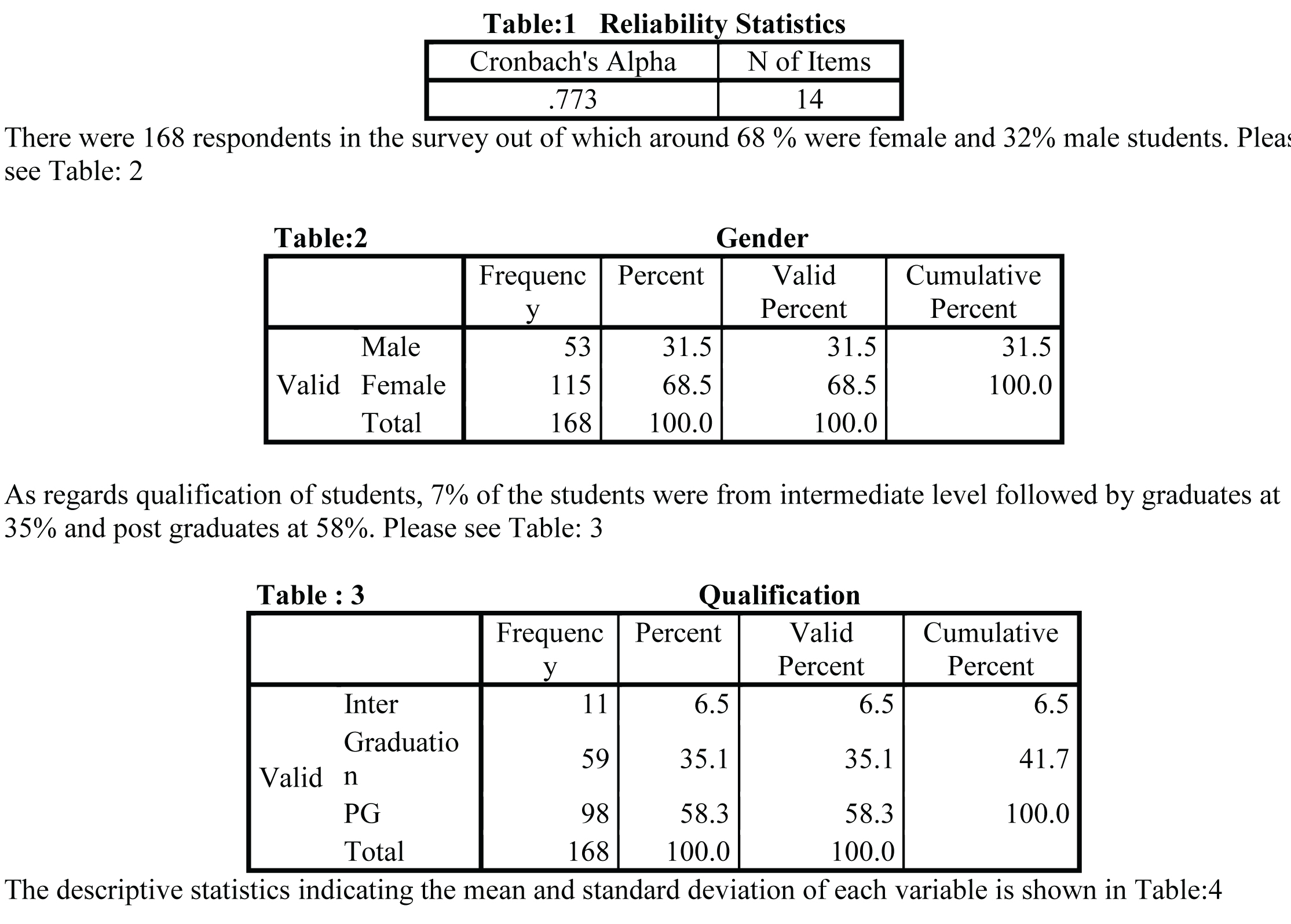
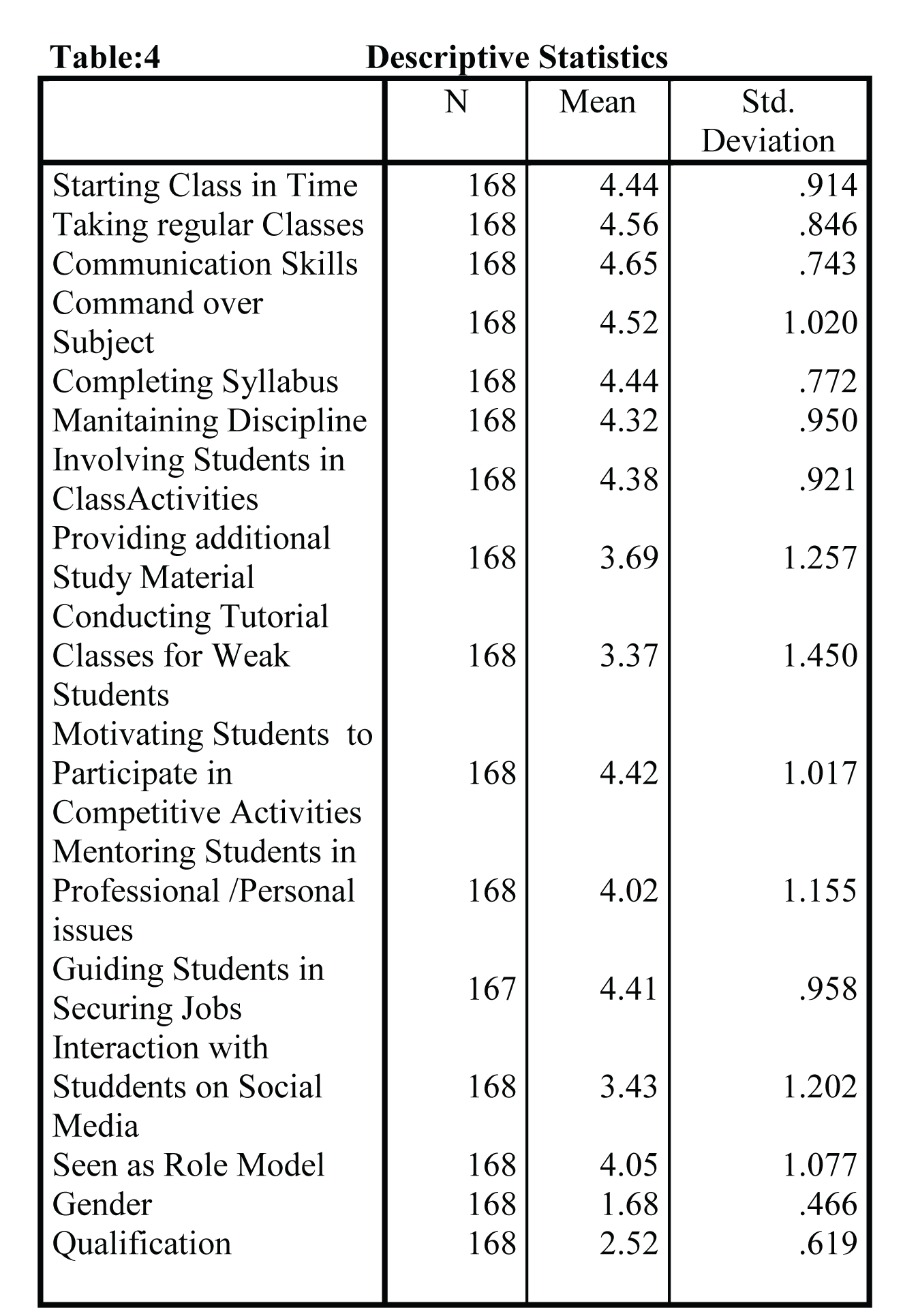
In order to identify the factors that describe faculty traits statistical tool, Factor Analysis, was undertaken using SPSS to reduce the variables into manageable few. The sample adequacy score on KMO was found to be in acceptable limit of 0 .734.Further, Bartlett’s test of sphericity with significance value p<.05 was found to be suitable for factor analysis. Please see details in Table: 5
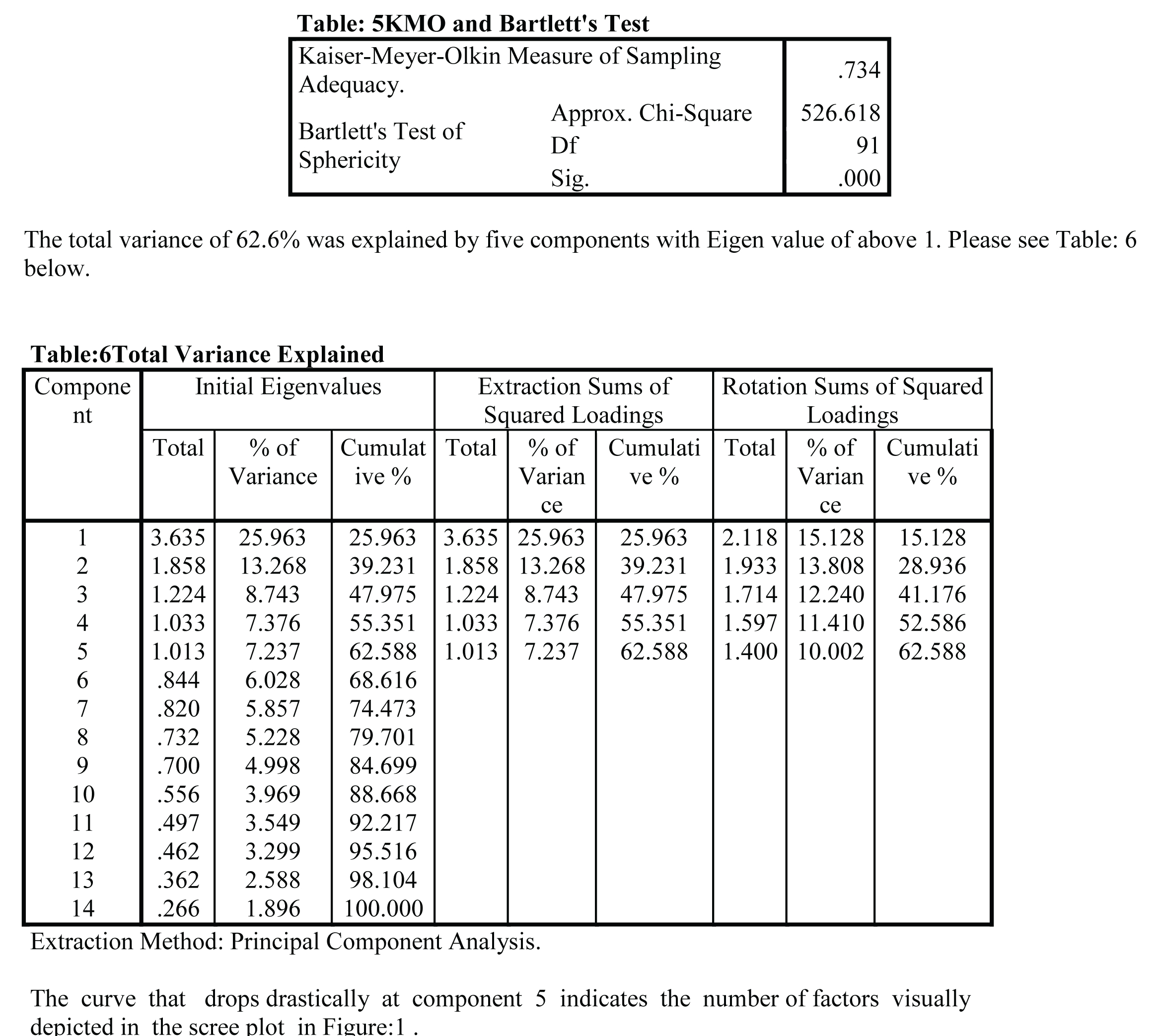
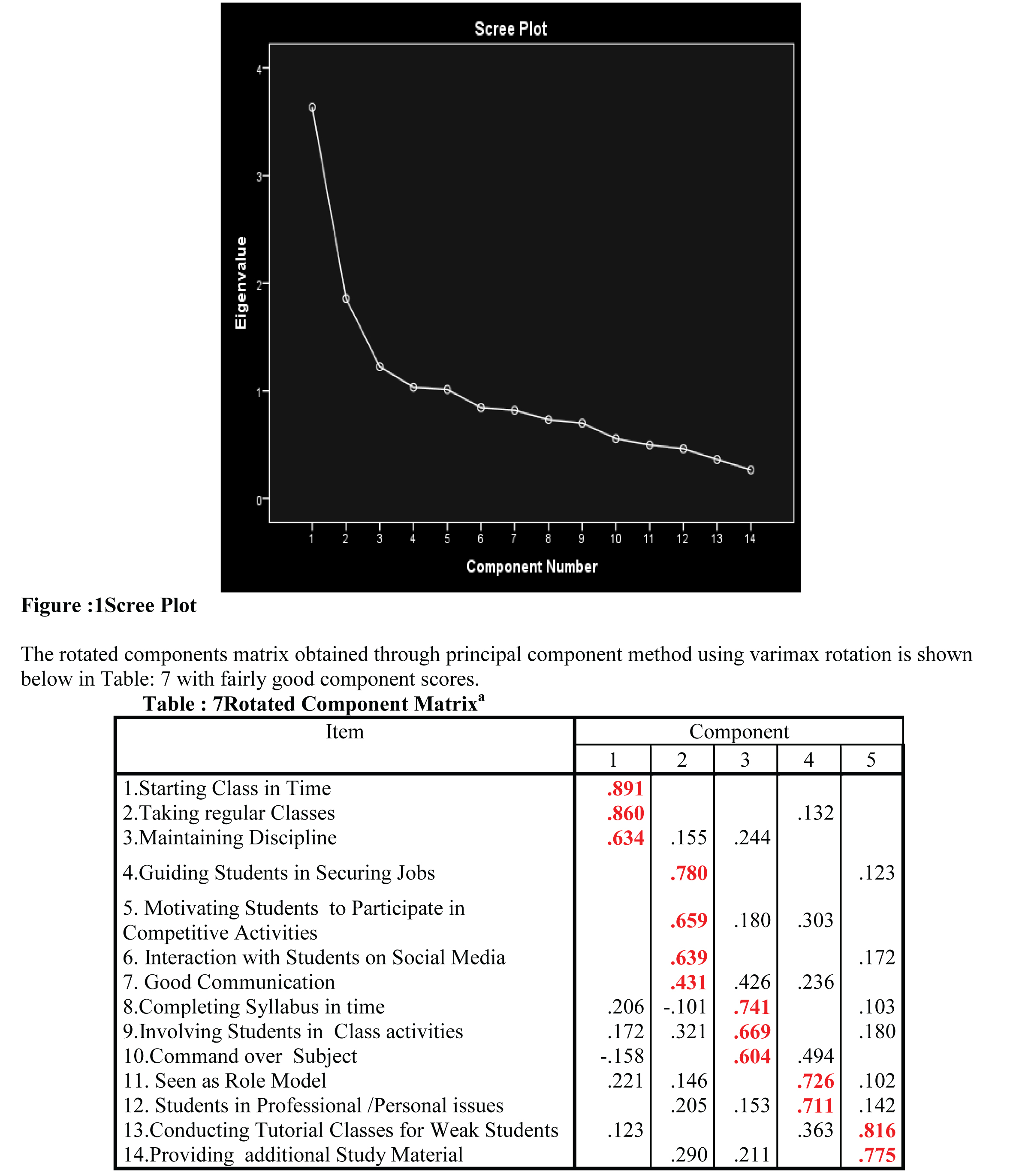
Extraction Method: Principal Component Analysis.
Rotation Method: Varimax with Kaiser Normalization.
Factors:
The five factors that emerge out of the statistical analysis are named as per the column one in the Table: 8 which appropriately recognise a teacher/ lecturer as Disciplinarian, Facilitator, Competent, Influencer and Compassionate.
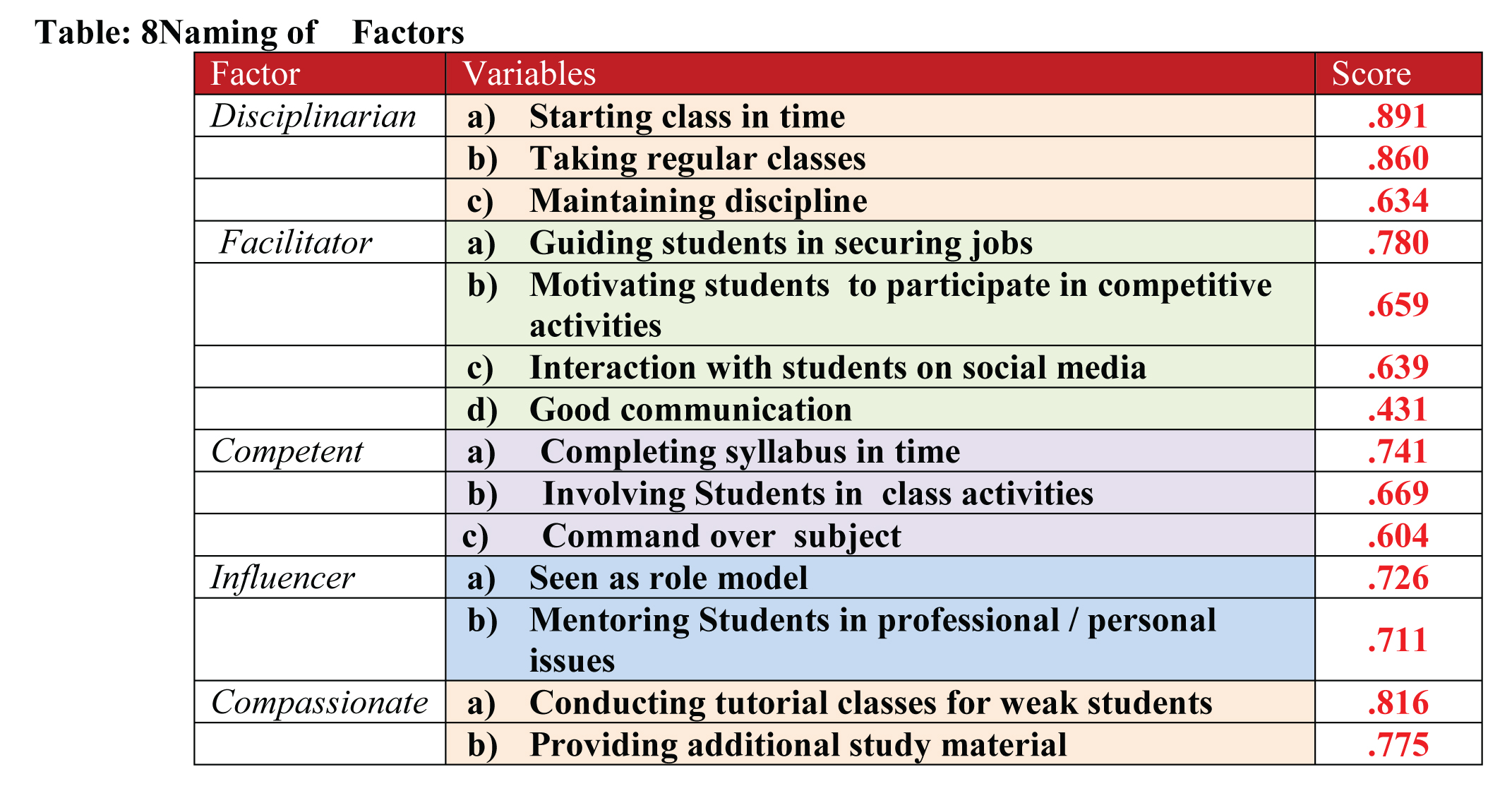
8. Conclusion and Discussions
A teacher is a disciplinarian, facilitator, competent, influencer, compassionate and many more. He/she is endowed with numerous traits as is seen from the findings and review of literature so as to be accepted and respected by students. A teacher’s role is a critical one and cannot be treated as a temporary or stop gap arrangement. Only those who have a passion for teaching should take up the profession. Similar to the expectations of students, faculty also expects few qualities and responsibilities from students to have a rewarding classroom experience. Due to few botched initiatives like fee reimbursement scheme for economically backward class students introduced by governments coupled with students’ lack of interest in studies due to various demands brought in by social media and internet, education system is facing an identity crisis. However, the role of a teacher and his/her responsibilities are bound to be critical and would increase with the advent of information technology in education system.
8. Future Research Possibilities
Having done a study on students’ expectations of teachers, a similar study to have teachers’ perspective of student’s conduct and their responsibilities in the classroom/institutions could be undertaken to compare and find gaps, if any. The exercise could provide valuable information to take corrective actions and make the education system more effective.
References
- Cox, Janelle (2020, February 11).Student Expectations for Beginning Teachers-What to Realistically Expect of Your Students. Retrieved from https://www.thoughtco.com/student-expectations-for-beginning-teachers-2081937
- Cox, Savannah (2017, February 20). What are Students Expectations of Teachers While Checking In?Retrieved from https://www.teacherready.org/students-expectations/
- Dennison, Emily (2019, February 8). 10 Qualities of a Great Teacher Retrieved from https://www.snhu.edu/about-us/newsroom/2017/12/qualities-of-a-good-teacher
- Hall, Mercer and Russac, Patricia(2013,August15).What do students expect from their teachers?[Blog Post].Retrieved from http://theasideblog.blogspot.com/2013/08/5-things-students-expect-from-their.html.
- Havighurst, Robert J (2018, August 15).Role and Functions of a Teacher.Retrieved fromhttps://www.britannica.com/topic/teaching/Functions-and-roles-of-teachers.
- Hirsh, Stephanie (2014, November 12). 7 Responsibilities of Teacher Leaders [Blog Post].Retrieved fromhttps://blogs.edweek.org/edweek/learning_forwards_pd_watch/2014/11/7responsibilities_of_teacher_leaders.html.
- Kashyap,Diksha (2020, March 15). Essay on Teacher: Qualities, Roles and Responsibilities. [BlogPost].Retrieved from http://www.yourarticlelibrary.com/essay/teacher/essay-on-teacher-qualities-roles-and-responsibilities/63733
- Kuehn, Paul Richard (2019, October 26). Importance of Teachers to Students- Responsibilities of a Good Teacher. Retrieved from https://soapboxie.com/social-issues/Responsibilities-of-Every-School-Teacher
- Machin,Lynn, Hindmarsh,Duncan, Murray, Sandraand Richardson,Tina(2015).A Complete Guide to the Level 4 Certificate in Education and Teaching.(p31).Critical Publishing,3 Connaught Road, St Albans Herts AL3 5RX,
- Marler, Laura (2019, March 14).Understanding Student Expectations&EffectiveTeaching. Retrieved fromhttps://www.grad.msstate.edu/files/effective_teaching.pdf
- Meer, Syed Hunbbel (2018, September 7).Top 9 Characteristics and Qualities of a Good Teacher.Retrieved from https://owlcation.com/academia/Characteristics-Of-A-Good-Teacher
- Nola,A(2019, July 6).The 7 Roles of a Teacher In the 21st Century. [Blog Post]. Retrieved from https://etoninstitute.com/blog/the-7-roles-of-a-teacher-in-the-21st-century.
- Orlando, Maria (2013, January 14).Nine Characteristics of a Great Teacher.Retrieved from https://www.facultyfocus.com/articles/philosophy-of-teaching/nine-characteristics-of-a-great-teacher/
- Sander,Paul;Stevenson, Keith;King,Malcolm &Coates, David (2010, September 9).University Students' Expectations of Teaching. Studies in Higher Education, 25:3, 309-323, DOI: 10.1080/03075070050193433. Retrieved from https://doi.org/10.1080/03075070050193433
- Reynaud, Marianne (2010). QualityTime-ESL. The Digital Resource Book, Publisher-iUniverse, Inc, New York.ISBN-10: 0595486681.Retrieved from https://qualitytime-esl.com/spip.php?article317
- Stephaney, Shonette(2020, March 16).The Heart of Teaching: What It Means to Be a Great Teacher. Retrieved from https://www.education.gov.gy/web/index.php/teachers/tips-for-teaching/item/5515-the-heart-of-teaching-what-it-means-to-be-a-great-teacher
- Teacher Certificate (2020, March 16).The Many Roles of the Teacher. Retrieved from http://www.teachercertification.org/a/the-many-roles-of-the-teacher.html
- Tinnish, Sue (2019, December 13).Setting Student Expectations.Retrieved fromhttp://www.teachingtoolbox.us/expectations
- Umbach, P.D. and Wawrzynski, M.R. (2005).Faculty Do Matter: The Role of College Faculty in Student Learning and Engagement, Indiana University Centre for Postsecondary Research, Bloomington, IN 47406 , 46 (2), pp. 153–184. Retrieved from http://nsse.indiana.edu/pdf/research_papers/faculty_do_matter.pdf
- University Grants Commission (2018-19), Annual Report, NewDelhi-110002. Retrieved from https://www.ugc.ac.in/pdfnews/3060779_UGC-ANNUAL-REPORT--ENGLISH--2018-19.pdf.
- Weimer, Maryellen (2010, March 23). What Students Expect from Instructors, Other Students.Retrieved from https://www.facultyfocus.com/articles/teaching-and-learning/what-students-expect-from-instructors-other-students/.
